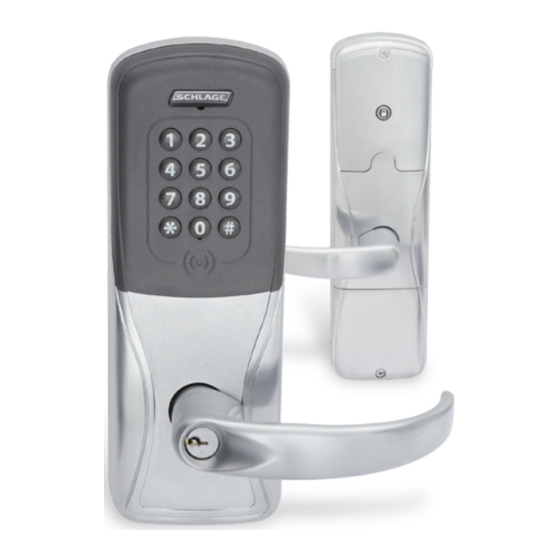Advertisement
Quick Links
Allegion AD-300 Installation
Application Note
Allegion Schlage AD-300 networked, hardwired locks can be integrated seamlessly with the Doors.NET software when
used with the NXT-MSC (Mercury-Powered controllers). You can connect and communicate with up to 16 AD-300s from
one controller via the RS-485 port. The AD-Series locks have extensive functionality and operating modes and are
combined units consisting of the electric lock, credential reader, Request-to-Exit and Request-to-Enter sensors, door
position switch and tamper guard.
For standard applications the AD-300 can be customized with a variety of credential readers including keypad, magnetic
stripe or multi-technology which can read both proximity and smart-card technology.
1.0
Hardware Requirements
Keri Hardware
•
Requires the use of NXT-MSC (Mercury Powered controllers) - (Mercury, standard NXT or PXL controllers do not
support Allegion wireless locks).
•
The controllers must be using firmware v1.189 or greater.
Allegion Hardware
AD-300 Lockset
2.0
Software/Licensing Requirements
Access the License Manager to verify you have the correct license settings:
Start > All Programs > Doors.NET > License Manager
•
Doors.NET Software revision v3.5.1.19 or greater
•
Mercury Powered controller licensing
•
Mercury gateway installed and configured
•
Allegion enabled
HHD (Hand Held Device)
Page 1 of 11
P/N: 01671-001 Rev. A
Advertisement

Summary of Contents for Allegion AD-300
- Page 1 Request-to-Exit and Request-to-Enter sensors, door position switch and tamper guard. For standard applications the AD-300 can be customized with a variety of credential readers including keypad, magnetic stripe or multi-technology which can read both proximity and smart-card technology.
- Page 2 Remove the top inside cover. Press and hold the Allegion button until two (2) beeps sound (10 seconds) then release. Press and release the Inside Push Button (IPB) three (3) times within 10 seconds... the button will beep and blink red with each press.
- Page 3 Application Note The Allegion button and IPB will both light green for one second and a one-second beep will be heard. This indicates that the lock has been reset. If IPB is not pressed 3 times within 10 seconds, two beeps with two red blinks indicating a timeout and procedure must be repeated.
- Page 4 Note: The HHD will use a default Programming Password (123456) when coupling with a device. The programming password should be changed to provide increased security for your locks. Plug the HHD’s USB cable into the AD-300’s USB port located underneath the exterior side of the lock. Remove the top inside lock cover of the AD-300.
- Page 5 Select the Edit tab. Select the RS-485 address you wish to assign to the AD-300 lock (all AD-300s wired into a bus of a controller needs a unique address number between 0 and 15) – You have daisy-chain up to 16 locks per controller bus.
- Page 6 Configuring Doors.NET for the AD-300 This section assumes the NXT (MSC) 2-door or 4-door controller is online, configured and ready to add the AD-300 to the database. (Refer to the NXT (MSC) controller Quick Start Guide for further details about setting up and configuring this controller type with Doors.NET).
-
Page 7: Extended Features
Right-click on the NXT-MSC 2/4 door controller and select Reset >> Memory. Extended Features There are several lock modes that are supported by the AD-300 series locks. You can set one of these supported modes by performing the following: Highlight the AD-300 in the hardware tree. - Page 8 Allegion AD-300 Installation Application Note You can right-click the AD-300 in the hardware tree or from the doors status grid and select Mode > Extended. You can setup a Local Linkage Procedure to set one of the extended modes. There are numerous system events that can be defined as Local Linkage Triggers but the event must be generated from the same controller to which the AD-300 is connected.
- Page 9 Allegion AD-300 Installation Application Note Extended Feature Descriptions Classroom/Storeroom Mode Lockset is normally secure. Inside lever always allows free egress. Valid toggle credentials on the exterior may be used to change to a passage or secured status. NOTE: IPB cannot be used.
- Page 10 Allegion AD-300 Installation Application Note 10.0 Setup and Configuring Credential Types Before setting up users or adding credentials to users, “Credential Types” must be configured to allow proper card and/or PIN operation. The Credential Types feature must be enabled on your license key within the Options section.
- Page 11 Allegion AD-300 Installation Application Note Smart Cards (13.65MHz) • aptiQ™ MIFARE Classic • aptiQ™ MIFARE DESFire™ EV1 • PIV and PIV-I compatible Smart Cards (13.65MHz) – Reading Card Serial Number (CSN) Only • HID iCLASS® • DESFire® • MIFARE® •...












Need help?
Do you have a question about the AD-300 and is the answer not in the manual?
Questions and answers